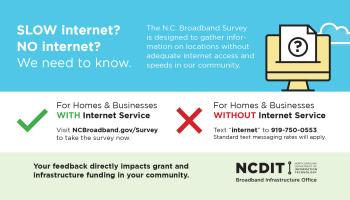The N.C. Department of Information Technology is launching the NC Broadband Survey to gather information on locations without adequate internet access and speeds in the state. The information gathered from the survey will provide clear data to guide investment of funds through the state’s Growing Rural Economies with Access to Technology (GREAT) grant program, inform research and policy recommendations, and support strategic targeting of additional funding streams. The survey is a collaboration between NCDIT’s (NCDIT) Broadband Infrastructure Office and the Friday Institute at NC State University.
The survey takes about five-minutes to complete and will be available in both English and Spanish. Participants are encouraged to also take the optional internet speed test to connect survey data with broadband speed information.
For homes or businesses with internet service, the participant should take the survey online, from the location being reported, ideally from a wired connection. This will allow the speed test and other survey data to be tied to the exact location. Visit ncbroadband.gov/survey to complete the survey online.
For locations being reported without internet service, the participant can take the survey by phone. Residents without internet service but with phones capable of text messaging can text “internet” to 919-750-0553. Standard text messaging rates will apply.
Residents with land lines or cell phones that do not have texting capability, may place a voice call to 919-750-0553. The interactive voice response system will guide them through a series of short questions to obtain their address and register it in the database as having no internet capability at all.
For all participants, we ask that you provide the street address of the home or business to help us identify areas needing improved internet access. Locations may be:
- mapped to show unmet needs or demand for high-speed internet.
- shared with relevant internet service providers or other partners to identify service solutions.
- included in a public map, with location points buered for privacy.







